“The customer is always right” is a motto that haunts the minds of anyone who has ever had to interact with the public at work. For retail associates, cashiers, customer service agents, and other public-facing positions, customer experiences are both the best and worst part of the job.
Helping customers find what they need and solving their problems is always fulfilling, but when something goes wrong, knowing how to deal with angry customers can be the difference between a lost sale and a negative review or a hard-fought victory ending in a positive experience.
Whether you’re a customer support agent looking to improve your conflict-resolution skills or a team lead who’s looking for ways to improve your team’s conflict-resolution skills, keep reading to learn how to handle angry customers and see some examples of dealing with angry customers you can learn from.
Why do customers get angry?
There’s nothing you can do to prevent customers from getting angry. Customers have certain expectations when they place an order at your store. Unfortunately, things sometimes go wrong in business, which is enough to cause frustration in customers – especially when their hard-earned money is involved.
As a customer service agent, these angry customers see you and your team as direct representatives of the company that wronged them, so they direct their anger at you.
While it can be tempting to leave the chat or stop replying to angry customers’ messages when they’re rude, it’s important to practice empathy. Take a step back and put the situation into perspective before making judgments. After all, they’re human too.
Your customer may have ordered a product for a birthday, anniversary, or other date-specific event, so if the delivery is late, it ruins the occasion. Or, being forced to contact your company to resolve their issue may interfere with their schedule or cause them stress, making them lash out. In some cases, financial or personal hardships can make their purchase more significant to them, and problems with their order can make those issues worse.
While you should never accept being abused by an angry customer, practicing empathy can help you remain level-headed and better salvage the relationship when managing angry customers.
Why should you learn how to manage angry customers?
It may seem like a lot of work, but learning how to manage angry customers is essential to effective customer service, both for the business’s success and your team’s well-being.
Angry customers are worth salvaging
Every customer is a business opportunity – even angry customers. While the last thing you want is to have an angry customer yell at you or give in to their demands, defusing an angry customer is incredibly valuable both for keeping their business and avoiding losing others’ business.
Frustrated customers will tell an average of seven people about their negative experiences, stopping potential customers from trying your products or services. If you can transform their negative emotions into satisfaction, you’ll prime them to shop with your brand in the future. Returning customers spend 67% more than new customers and cost less in marketing and sales.
Protect your team’s mental health and reduce turnover
Many recent studies have proven that repeated encounters with angry customers impact customer service agents both psychologically and emotionally. Learning how to deal with angry customers will help you protect your (and your team’s) mental health. You’re not just learning how to calm your customers down; you’re learning how to lessen the personal impact of these stressful situations.
Because of the damaging impact of working with upset customers, customer service attrition is as high as 45%, which is twice the average turnover rate in other departments. On a managerial level, teaching team members how to deal with angry customers while preserving their mental health can help with attrition. They’re less likely to want to leave your team if they’re no longer suffering from these situations.
Read on to explore some tactics for dealing with angry customers—and learn when disengaging makes sense.
Looking for new strategies to develop strong customer relationships? Check out our ebook, Conversational Support: A Guide to Personalized Customer Messaging.
16 tips for how to deal with angry customers
Dealing with angry customers takes careful practice. These 16 tips will help you learn how to respond to an angry customer while preserving your team’s mental wellness. They work when you’re answering customer calls, replying to emails, and chatting through SMS or any messaging channels.
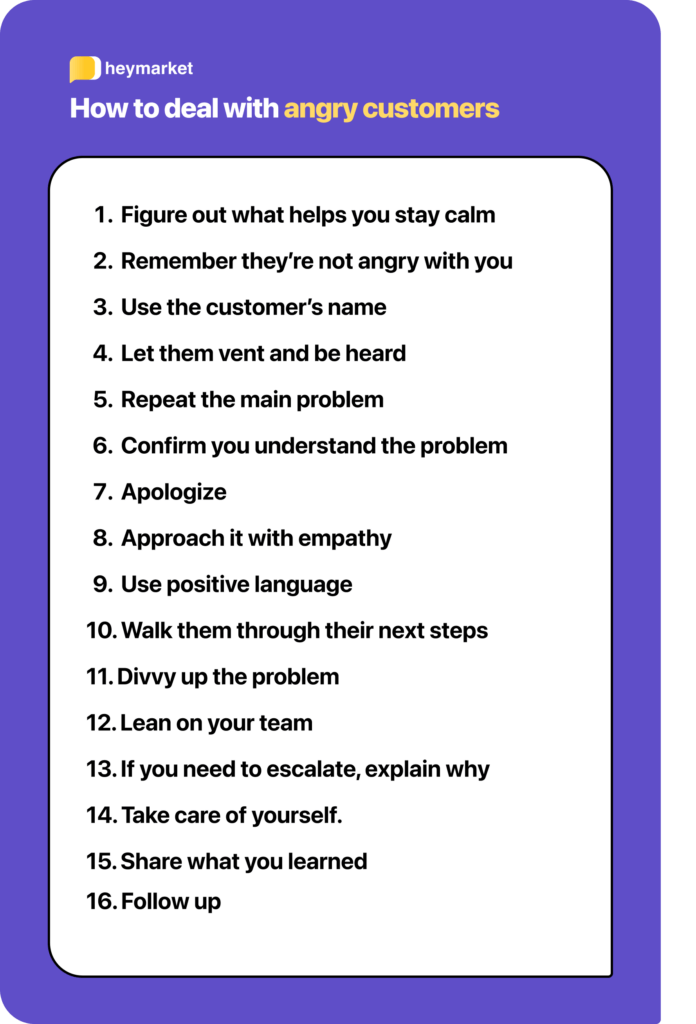
1. Figure out what helps you stay calm.
Angry customers might raise their voices over a call or use abrupt language over text. When this happens, it’s only natural to start feeling stressed and overwhelmed—or even upset that you’re a target for this kind of unfair treatment.
You’ve probably been told countless times to keep calm in these situations, but how do you actually do that? You have to figure out what technique works for you. Test out squeezing a stress ball, taking deep breaths, or focusing on your favorite meme taped to your monitor—whatever works for you. For inspiration, this online keep your cool tool provides a cool-down clock and examples of reframing your gut reactions with customers (and coworkers).
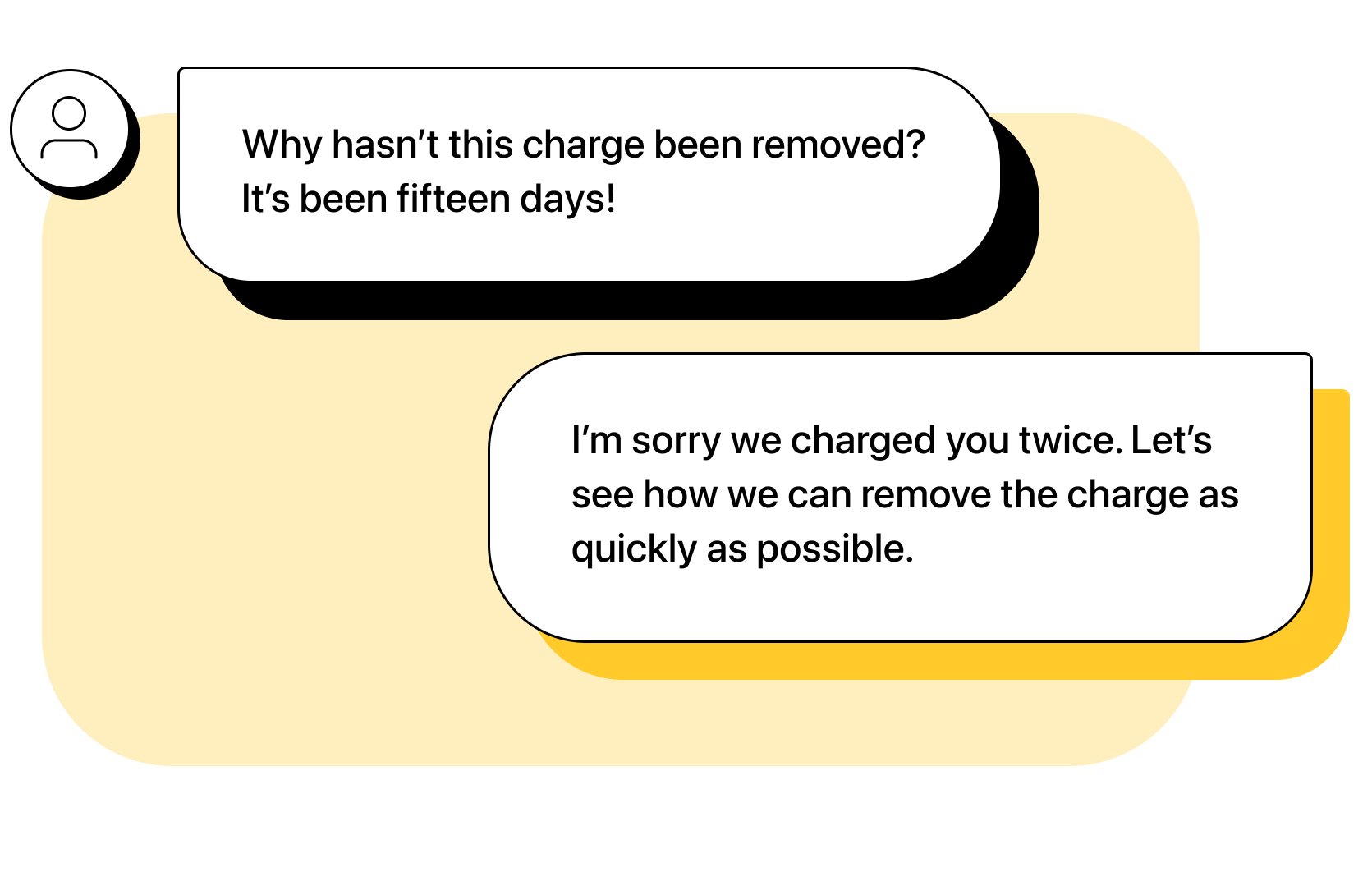
2. Remind yourself they’re not angry with you.
When an angry customer makes negative comments about your company or their experience, it’s easy to interpret them as reflections on your own work. Taking their words to heart can make you feel incompetent and guilty. But how do you avoid nurturing those feelings so they don’t take a toll on your wellbeing and interactions over time?
When a tense conversation starts, it helps to be ready with a routine or technique to remind yourself that your customer is upset with the situation, not you (even if it may seem otherwise). Try these before responding:
- Taking a full deep breath before responding
- Finding a phrase to repeat to yourself (like this one from Good Will Hunting: “It’s NOT your fault!”)
- Remind yourself you’re doing your best, and that your customer’s frustration is not because of you
Once you find your way to get there, not taking customers’ words personally helps you stay optimistic and fresh.
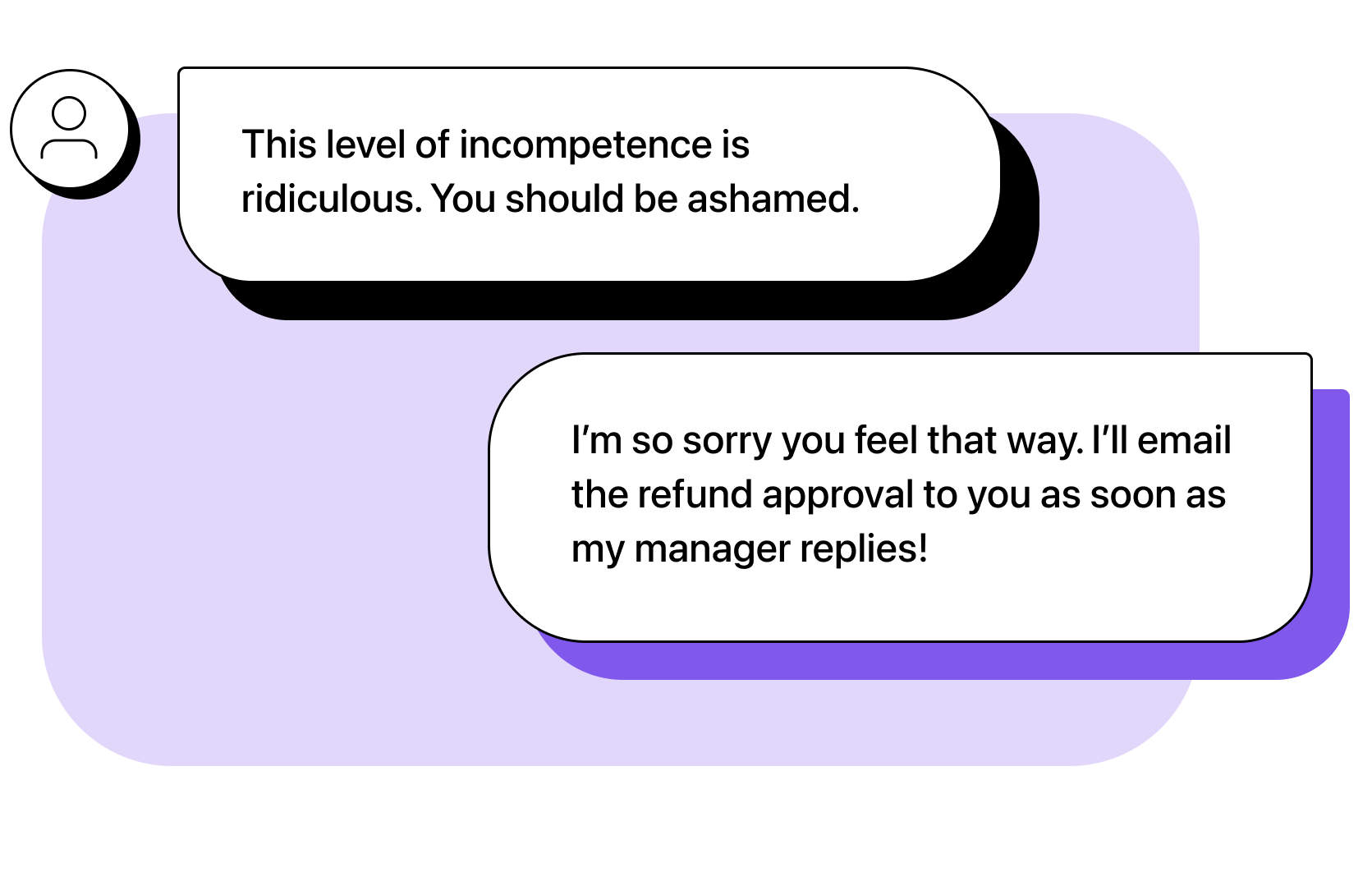
3. Use the customer’s name.
Upset customers are determined to have their voices be heard. One simple tactic for showing them that you’re listening and understanding them is using their name. (On the other hand, having them ask you repeatedly if you’re listening or if you understand what they’re saying could frustrate them further.)
Dale Carnegie, author of How to Win Friends and Influence People, believed that using a person’s name was key to getting them to like you. While you shouldn’t repeat your customer’s name too often, use it two or three times. This will help them understand that your attention is focused on them and solving their problem.
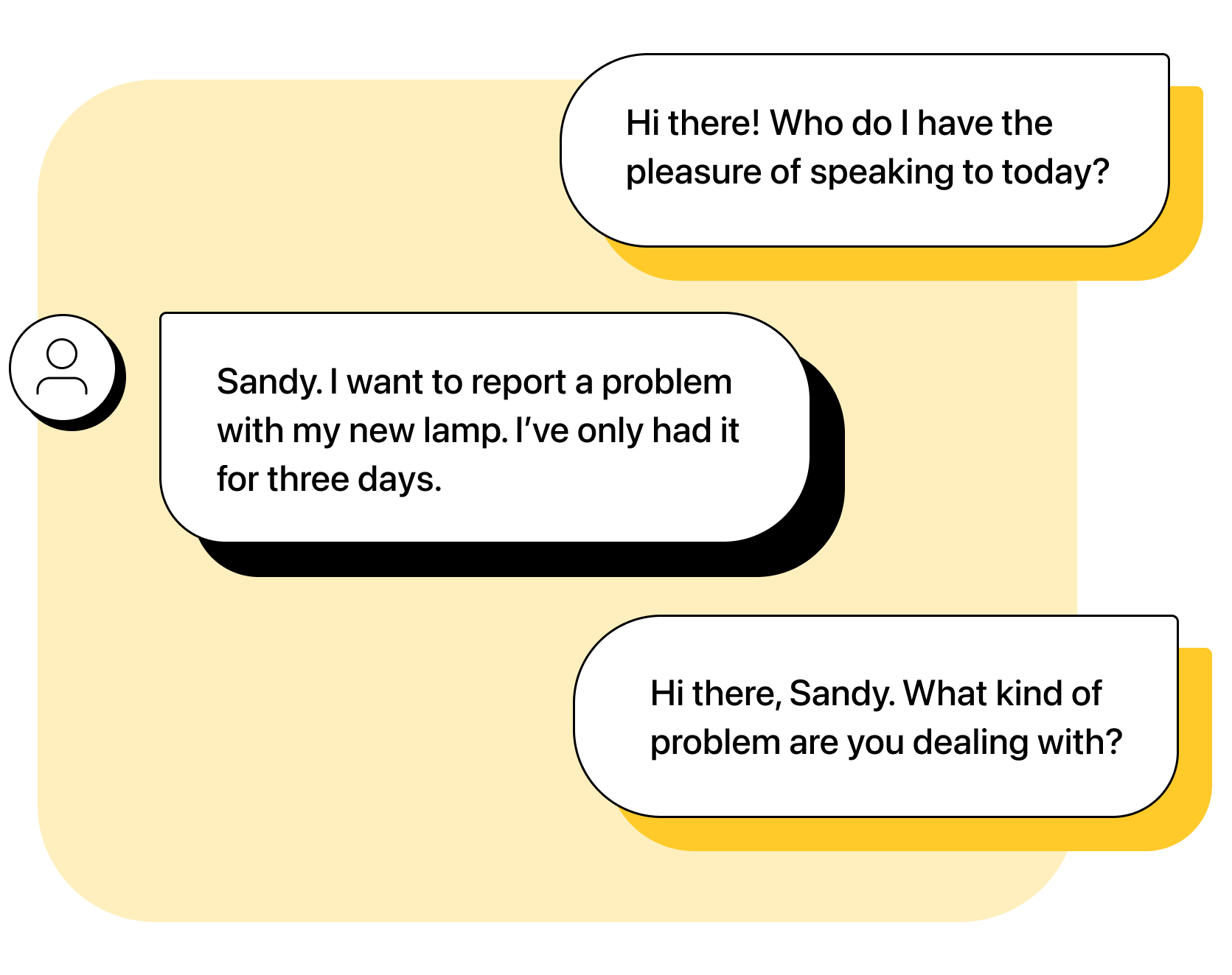
4. Let them vent and be heard.
It can be hard to understand what customers are saying when they are extremely upset. They may focus on their feelings or be too angry to clearly explain their problem. You might feel tempted to jump in with a solution so you can solve their problem faster.
Instead, listen to them without speaking even if you think you already know the solution. Interrupting may make you seem impatient. You may even miss important details that can help solve their pain point.
5. Repeat the main problem.
Active listening is most often a sales technique, but it’s worth borrowing it for customer service when situations get tricky. Once you’ve listened to the customer, repeat their main problem. Paraphrase it or put it into your own words. This way, you can ensure you and your customer are on the same page—getting you one step closer to solving their issue quickly.
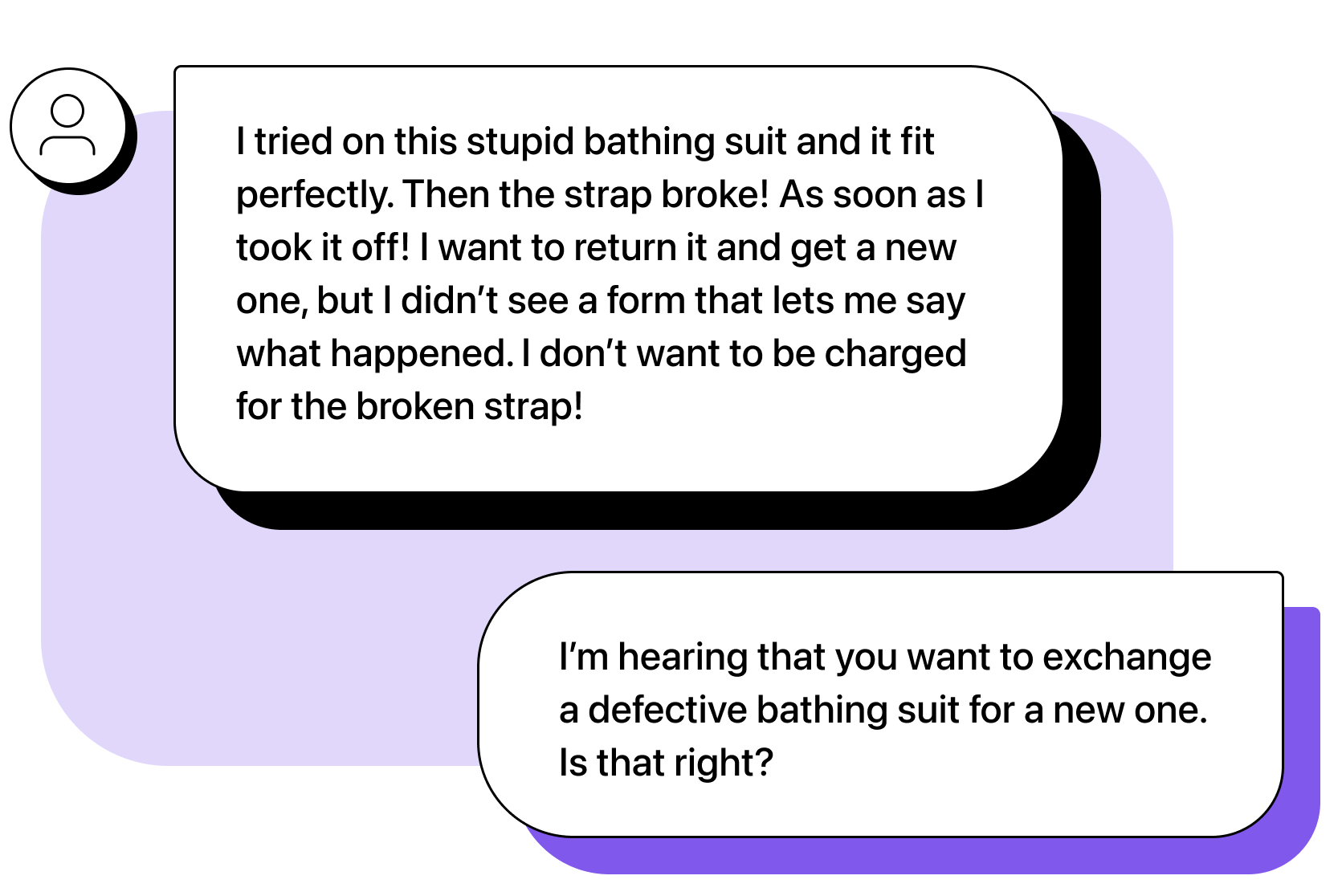
6. Confirm that you’ve got their problem right.
After you repeat the customer’s problem, ask an open-ended follow-up question. Open questions allow customers to express themselves in detail so they feel heard. For example, you may ask if they can add to your summary of their problem. Listen carefully to any additional notes. If they say “That’s it!” you’re ready to continue.
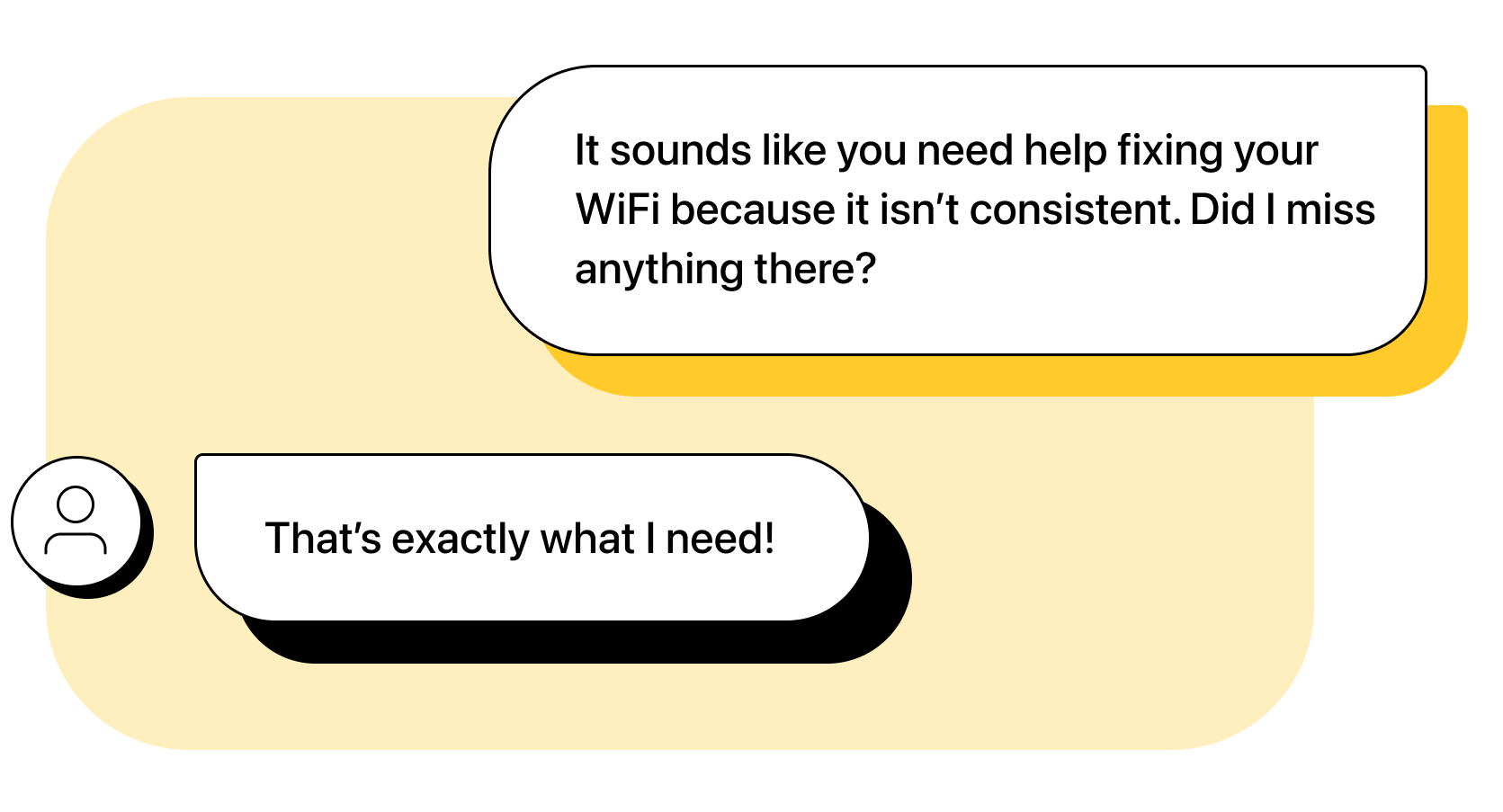
7. Apologize.
You’re the face of your business for the duration of your call, email, or SMS customer service conversation. Once you hear their problem and confirm it, apologize on behalf of your business and acknowledge any mistakes. Take the time you need to show them that you mean what you say; customers are good at sniffing out insincerity.
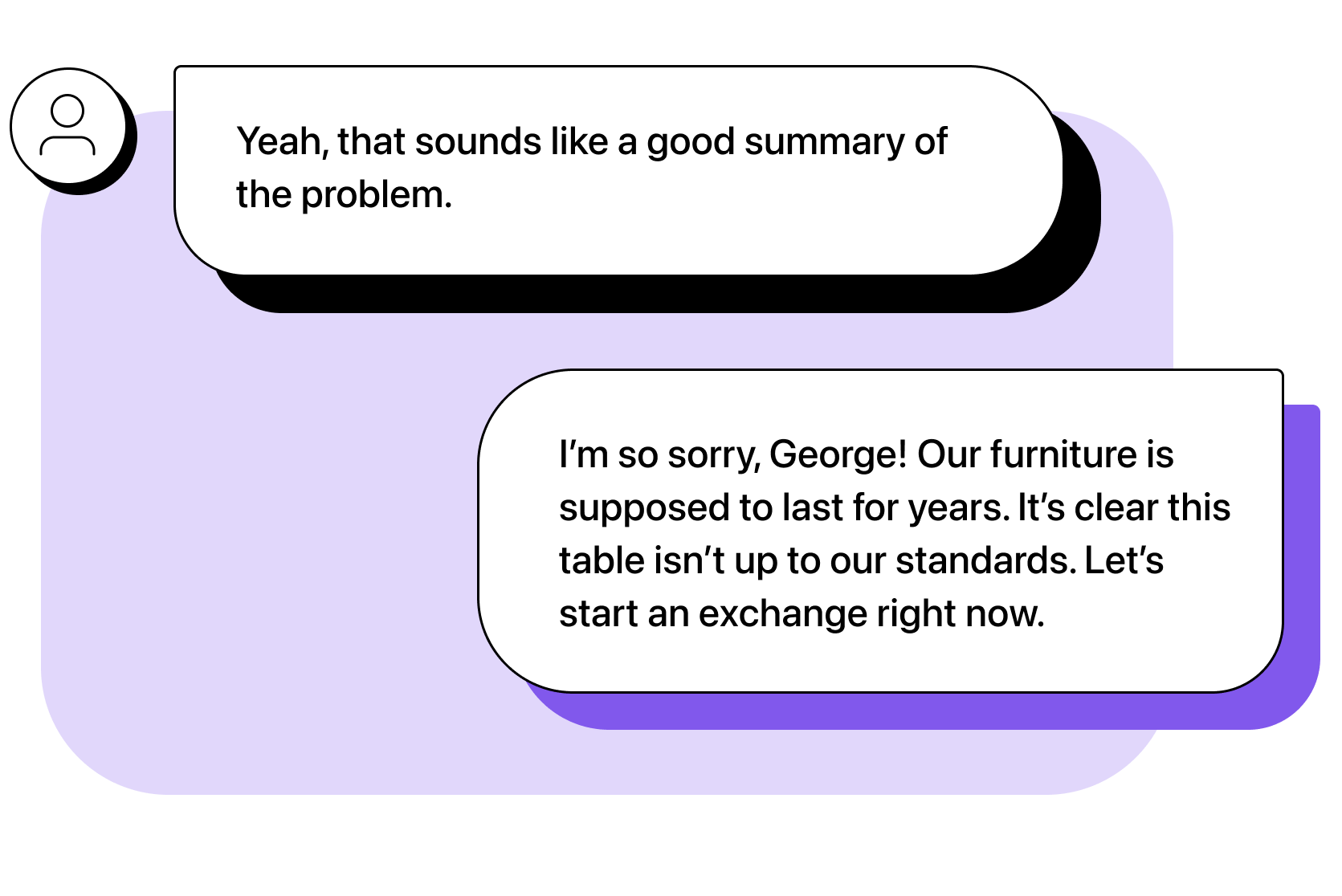
8. Approach it with empathy and understanding.
Since the start of the COVID-19 pandemic, customers have come to expect more authentic interactions with agents, especially over messaging channels. You can meet that need by reflecting on the issue they’re describing. This is much easier said than done: the customer is most likely venting about an issue with your product or service. Still, a few words of understanding go a long way.
Tell customers that you understand where they are coming from and why they are so frustrated. While you shouldn’t focus on yourself by sharing similar stories, show that you understand their feelings.
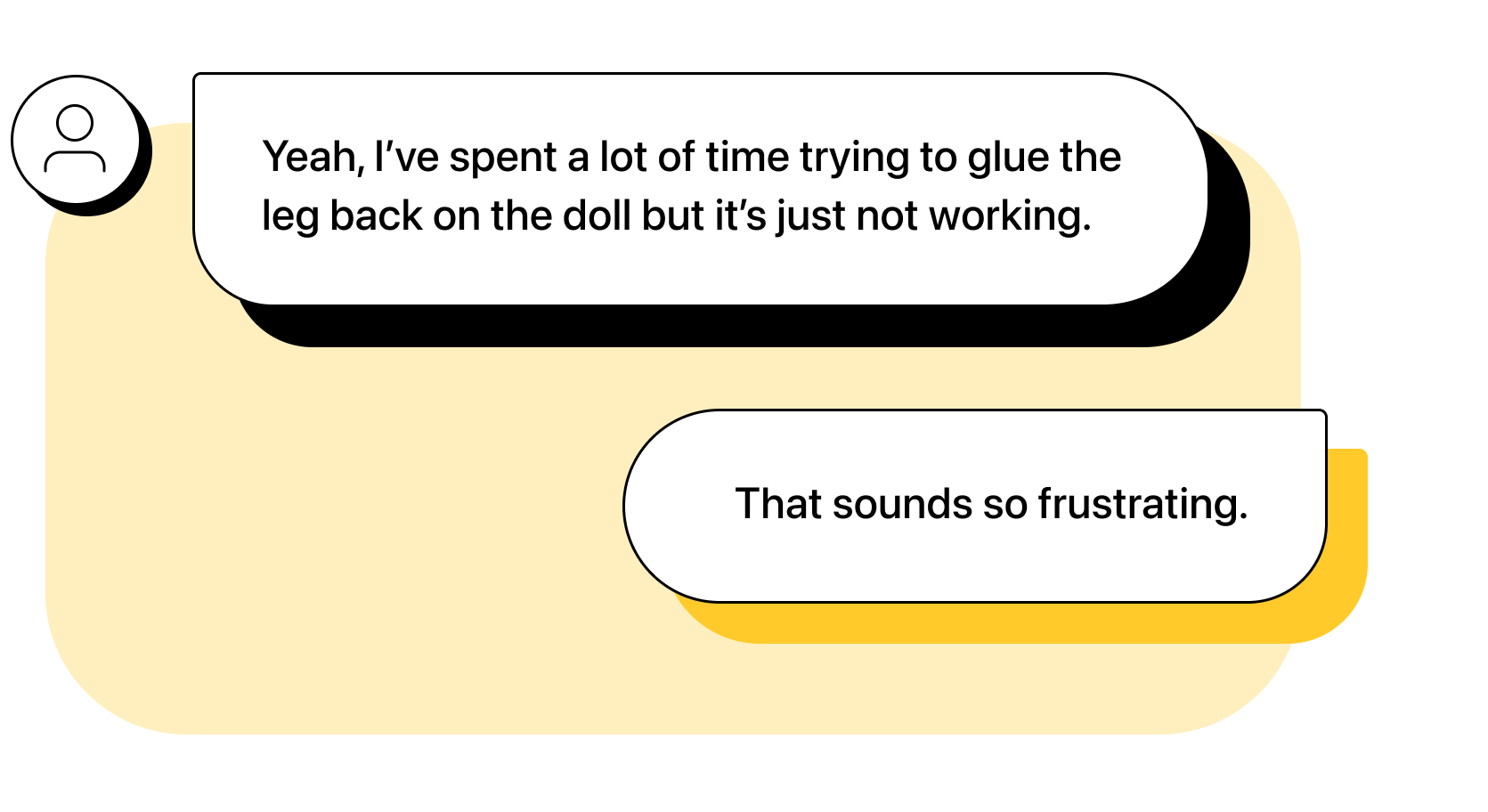
9. Use positive language.
Language is powerful. When a customer is angry, you can lean on how you phrase things to help control the situation. Rephrase your sentences to focus on the positives of the situation. Refocusing your language can help your customers see the bright side, too.
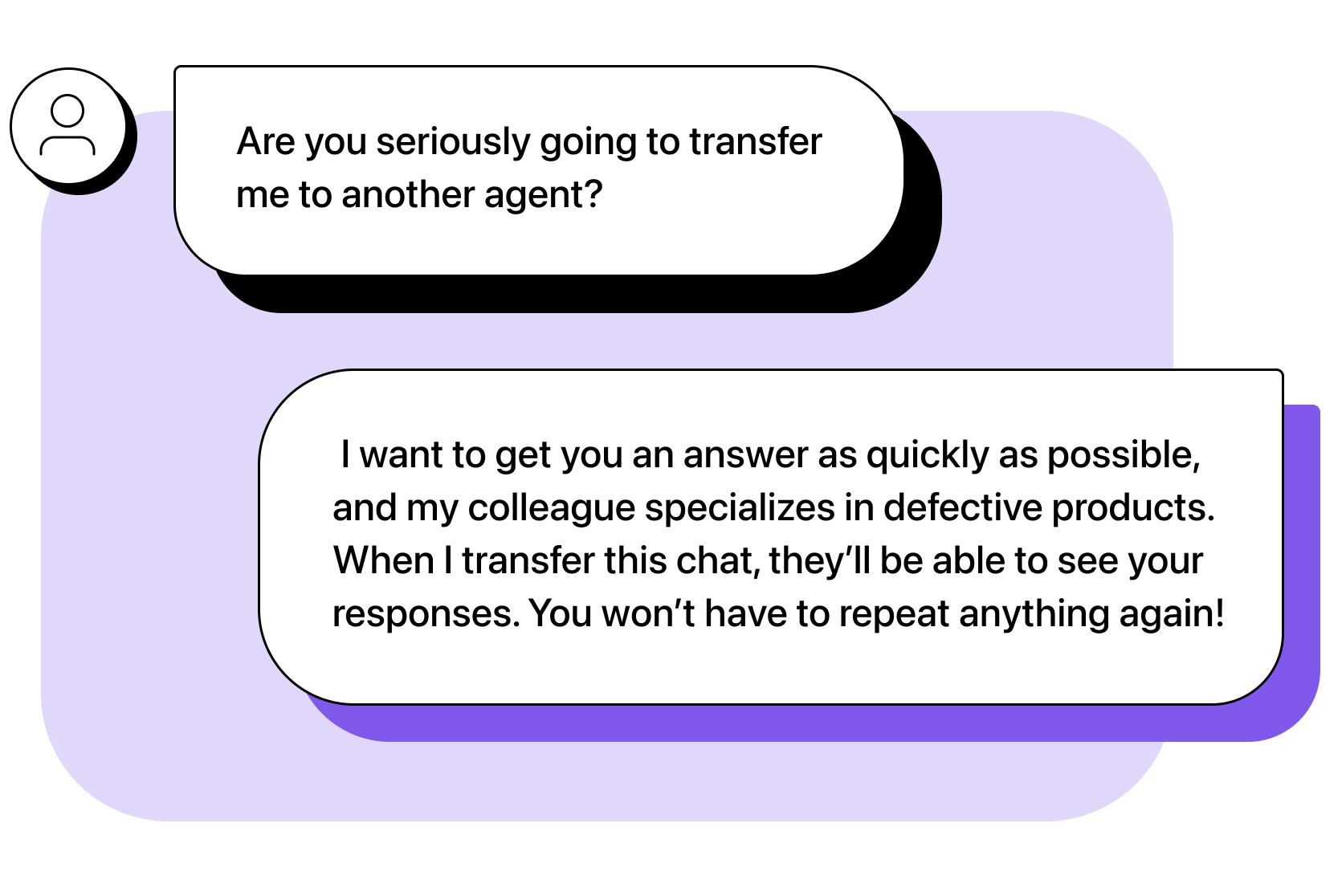
10. Walk them through their next steps.
Customers want to know what you plan to do so they can start to relax—it takes a lot of energy to get angry. Even if it’s a long process, explain exactly what you’re going to do next and how they will participate with you (if they need to). If you can, share an estimated timeline so they have an even better idea of what to expect.
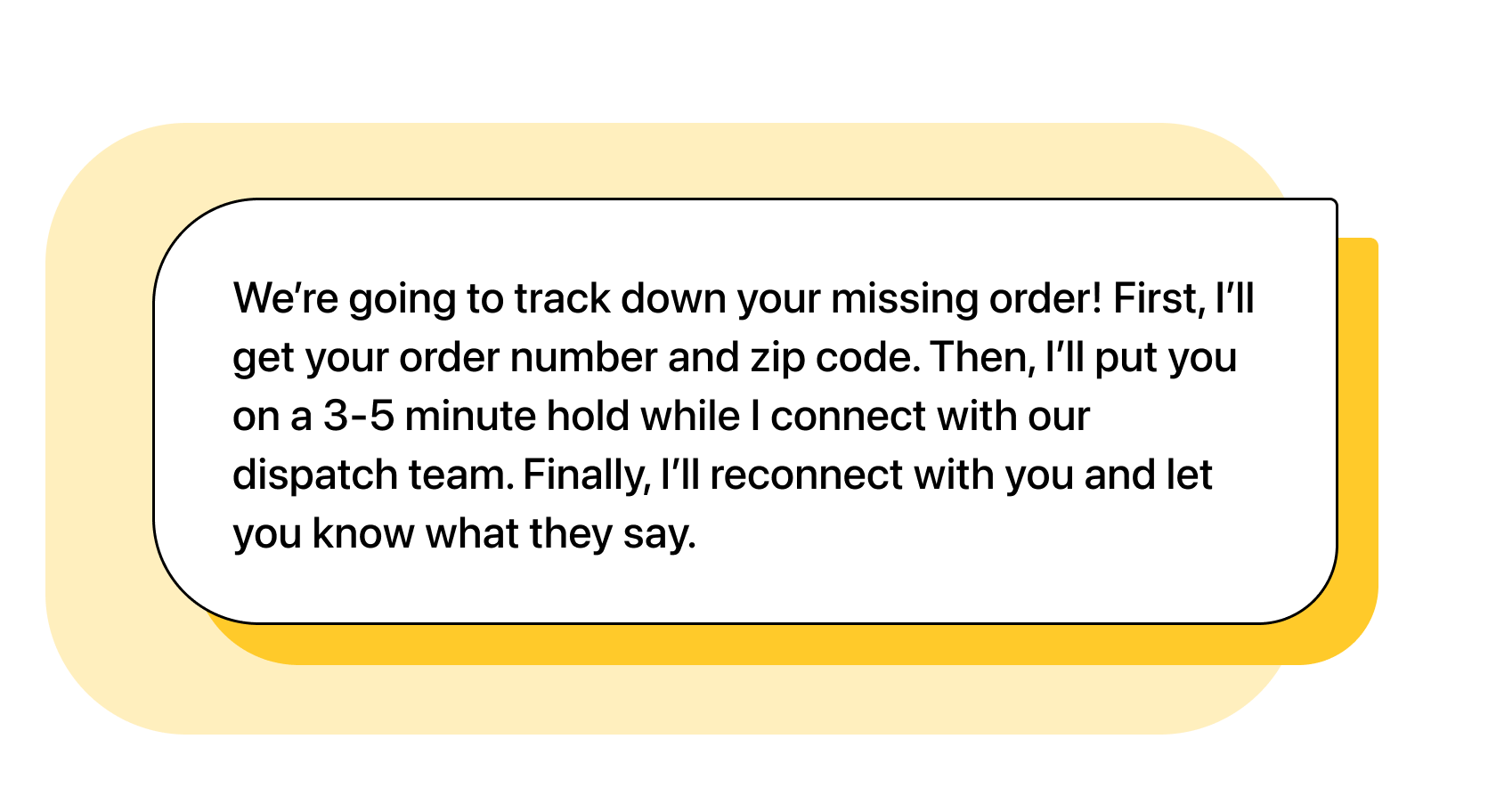
11. Divvy up the problem.
Chunking is a psychological term that involves taking a big problem and breaking it down into parts that are easier to tackle. Try this with tough customer interactions. For example, if you’re facing a multi-pronged problem, you can chunk it into smaller pieces to make it easier to manage for both you and your customer.
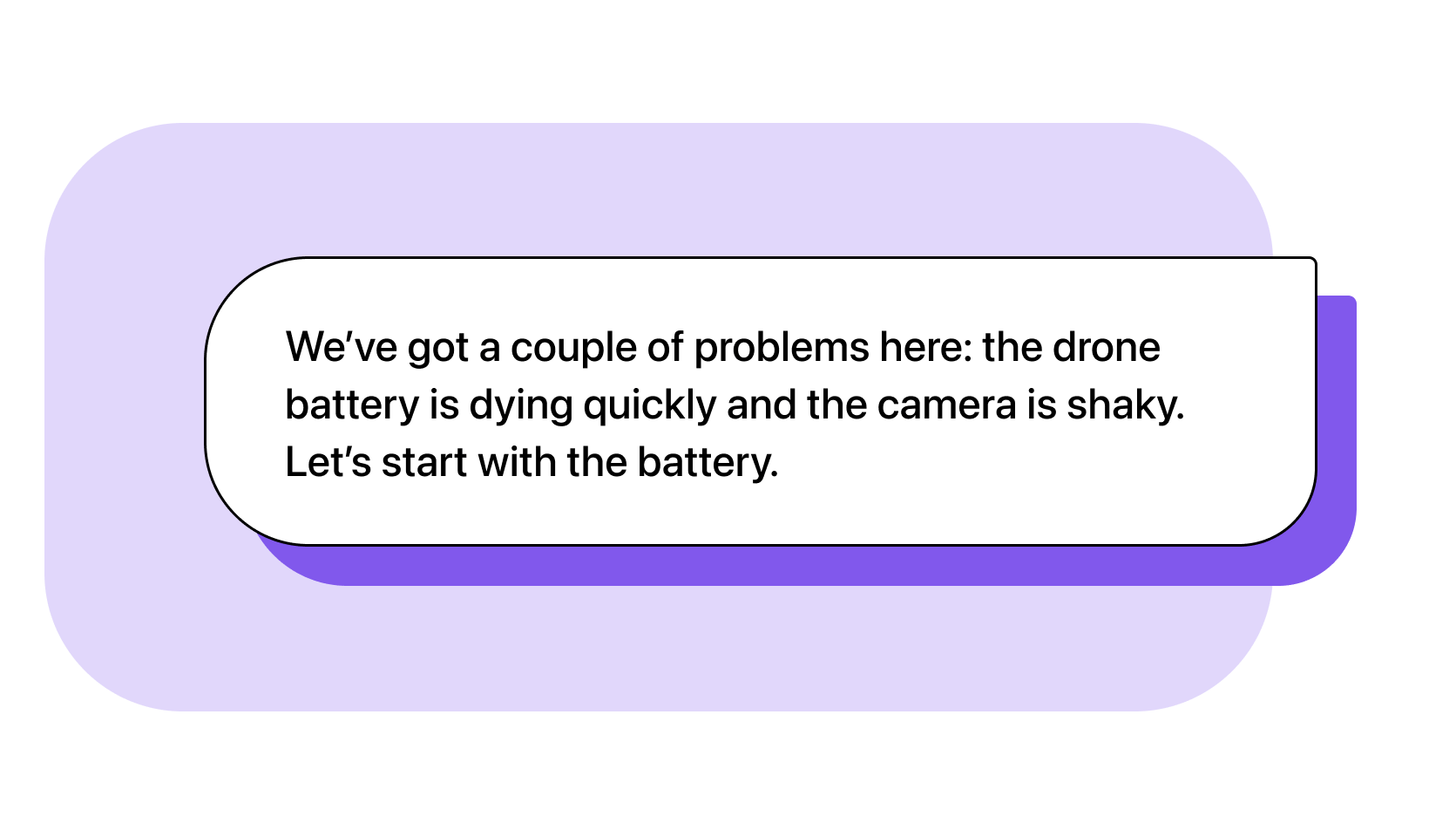
12. Lean on your team.
When a customer call or chat gets tense, it’s easy to forget that you have other people around you to help you find the right answer. The customer might need something that’s not in your focus area, or you might have more senior team members who are happy to help.
Focus on giving the customer the right answer, even if that means sending a quick Slack or private comment to your teammates. It’s worth the extra few seconds the customer might need to wait. (But on that note: try to speed up the process by using chats or internal notes so your team members can respond quickly.)

13. If you need to escalate, explain why.
Even if escalation often frustrates customers further, it’s sometimes unavoidable. But when you need to send their complaint to your manager or a specialist, explain to the customer why you’re taking this step and reassure them that it will help solve their problem.
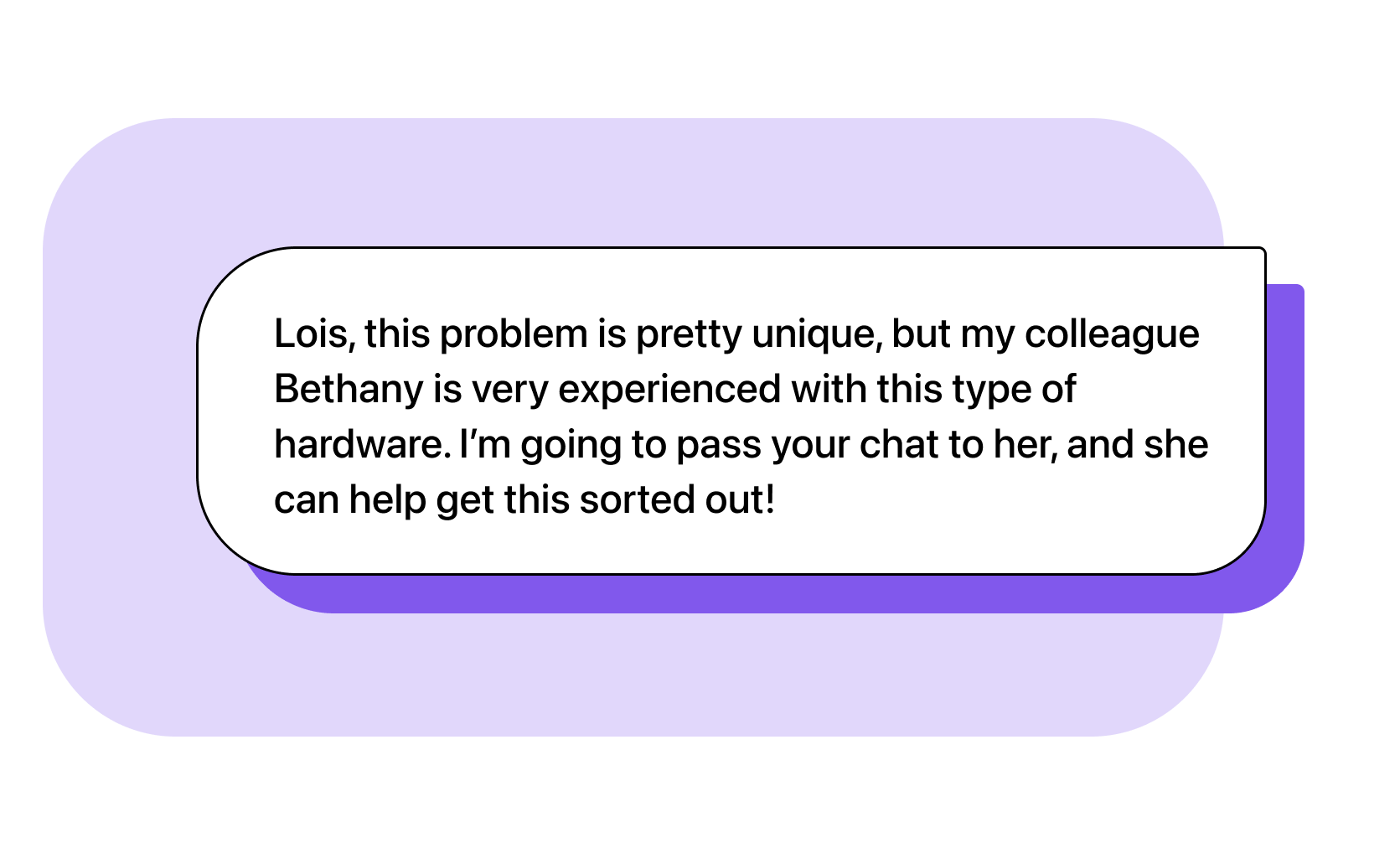
14. Take care of yourself.
Angry customers can make you feel stressed, especially if they remain stressed throughout the conversion. The longer you experience customer service stress, the worse you’ll feel and the harder it will be to help other customers.
After you have a difficult customer conversation, avoid going directly into your next task. Take a couple of minutes to clear your head: Take a 5-minute walk, use calming techniques like breathing carefully, or talk to your manager or coworkers for support. Even watching a quick stress TikTok video can take your mind off things and reset your mood for your next conversation. Remember to maintain good work/life balance so you can get your mind off stressful conversations that occur at work.
15. Share what you learned.
Angry customers can still be informative for your team. If you hear a complaint that your team can expect to hear again, share it with them. They’ll be prepared for incoming questions. Your team may even be able to proactively solve the problem before you get more incoming queries about it.
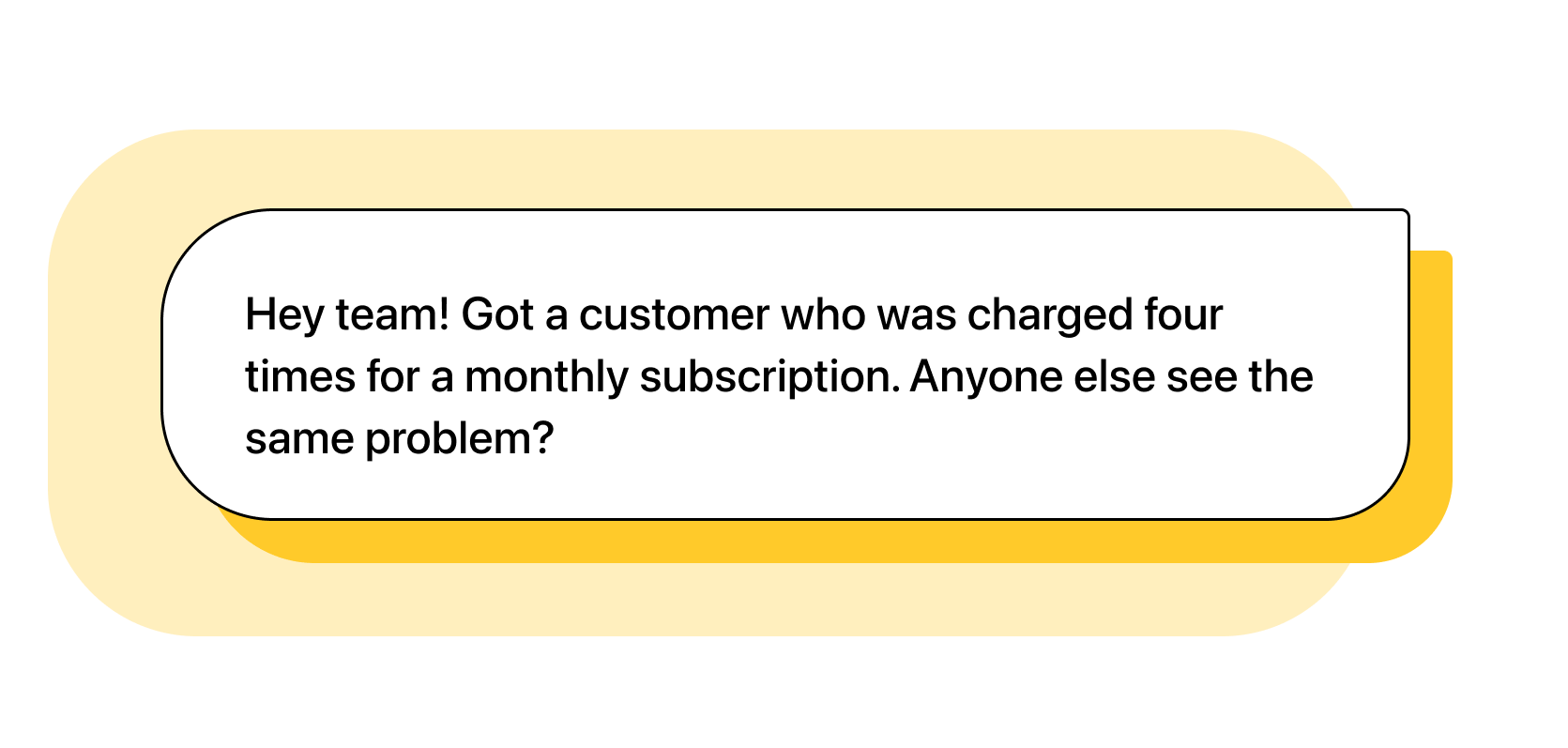
16. Follow up.
Follow ups are key to ensuring formerly-angry customers are still happy. They keep the lines of communication open so you can address any new problems. If the customer called in, send them an email or text follow-up. If they emailed or messaged, send a follow-up in that respective channel. With a text service for business, for example, you can schedule a personalized followup right after your initial chat.
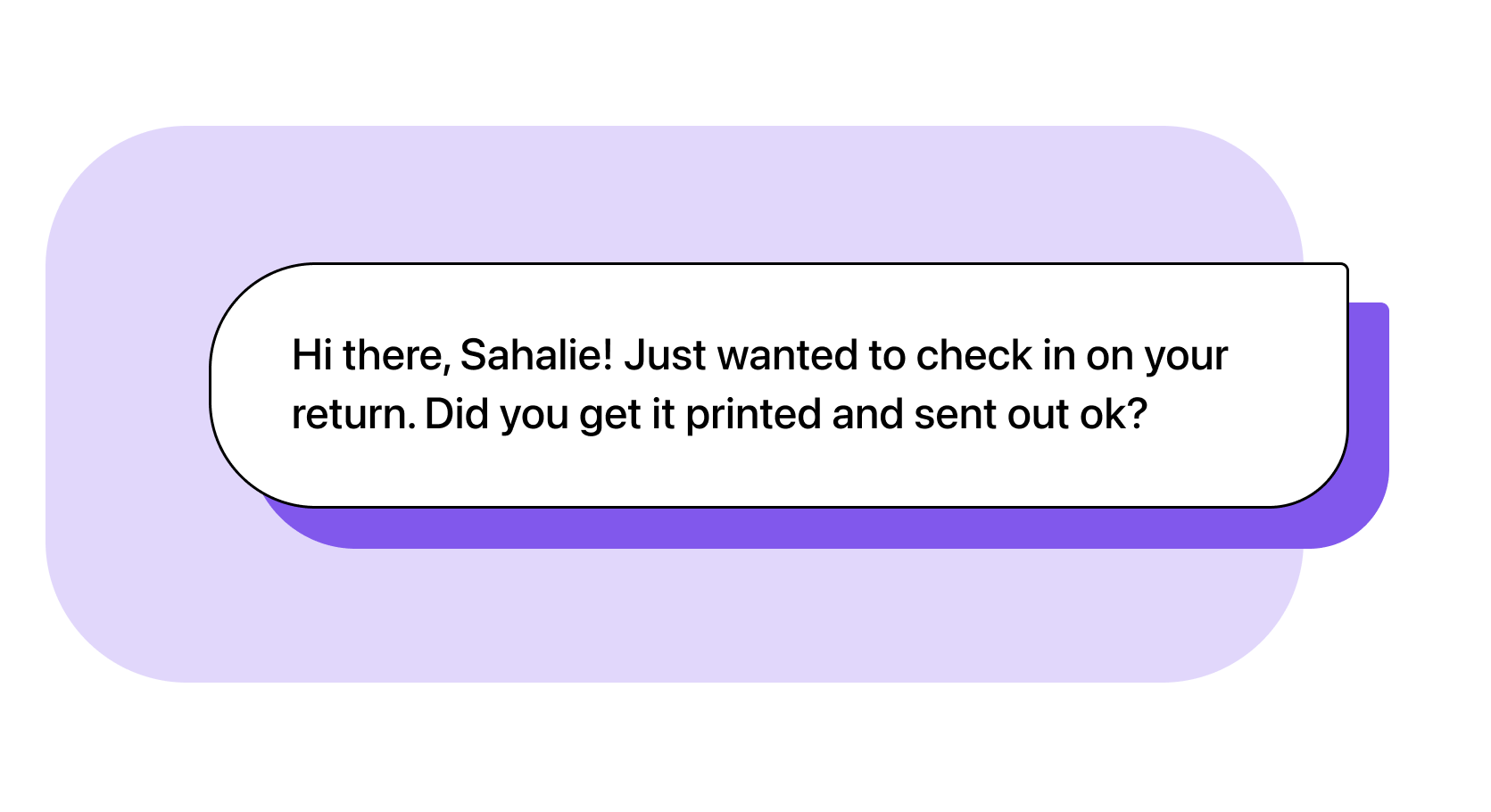
5 Examples showing how to deal with angry customers
Now that you know effective strategies for dealing with angry customers, it’s time to learn how to put them into practice. Here are five common customer service scenarios where your skills can come in handy.
An order is running late
80% of customers say that shipping speed is crucial to their online shopping experience. When they place an order and receive an estimated delivery window or day, that becomes their expectation. They may have chosen your store instead of a competitor’s because of the shipping estimate you provided, or have a time-sensitive order for an event that can’t be late.
If your delivery happens sooner, it’s usually a positive as long as you provide effective tracking and updates to ensure they know when to get their package. However, if delivery is later than expected, it can cause a negative customer experience that hurts retention and leads to angry customers.
You can work to defuse the situation by acknowledging the inconvenience the delay has caused, verifying shipping information, investigating the issue, and providing a truthful reply along with working to help make it right with discounts or other offers for the trouble.
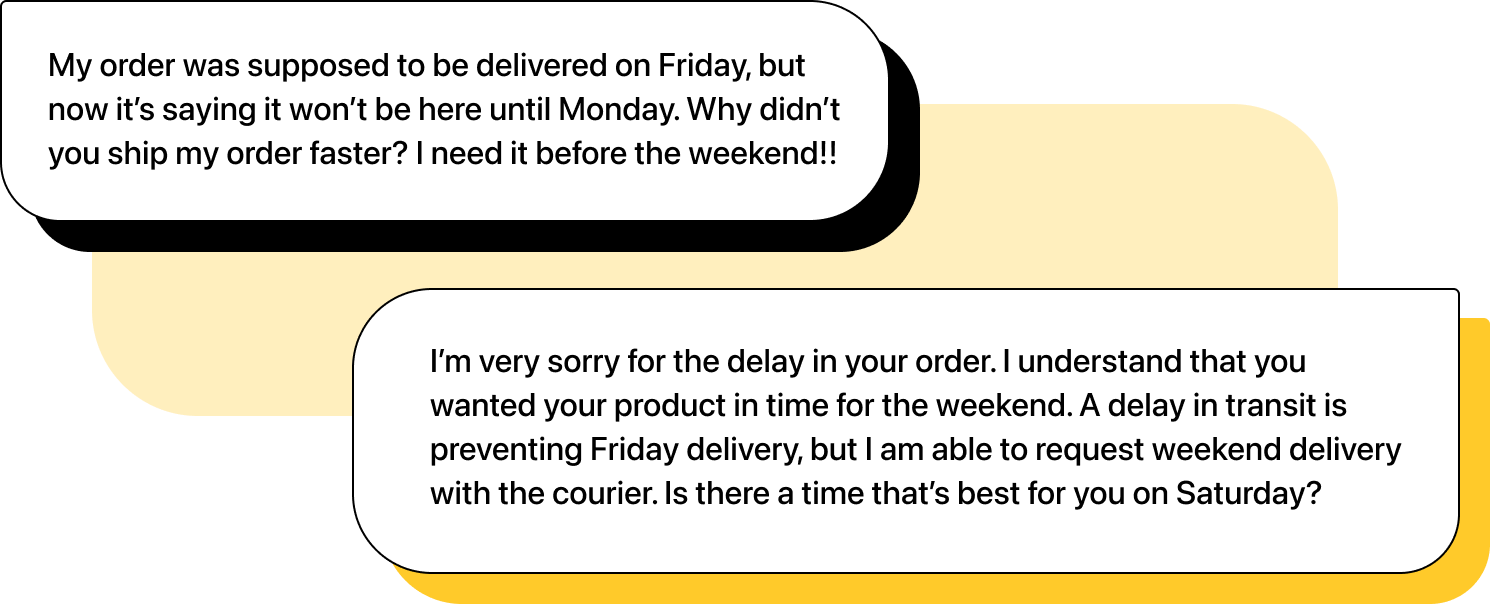
A customer was double-charged
Although they’re not very common, double charges can be exceptionally inconvenient for your customers. Whether they placed a duplicate order by accident or your payment processor had an issue, it’s taking money out of their pocket temporarily, which can cause stress and financial hardship that causes angry customers.
You should apologize to the customer for the mistake, even if it’s not your fault, and check where the charges come from. If possible, initiate a refund immediately and provide them with an estimate on when it will be processed. Then, assure them that you’ll contact the payment processor to avoid future mistakes.
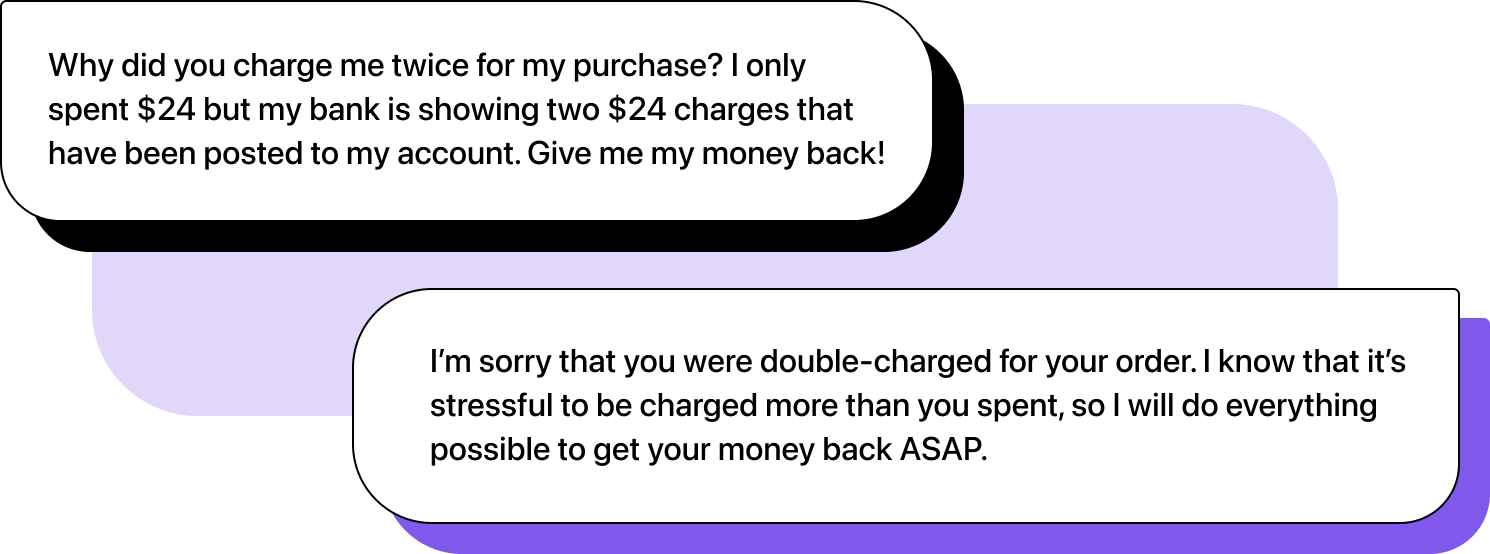
A product wasn’t up to par
Unfortunately, not every sale is going to be a slam dunk. Both faulty products and misunderstandings about a product can lead customers to be unhappy with their purchase, which may cause feelings of betrayal or being ripped off.
When you help an angry customer with a product complaint, be sure to collect information about what went wrong, including any defects or unclear product descriptions that led to the misunderstanding. You should also assure them that you’re working to improve it to avoid future problems while offering resolutions like returns, refunds, or replacements.
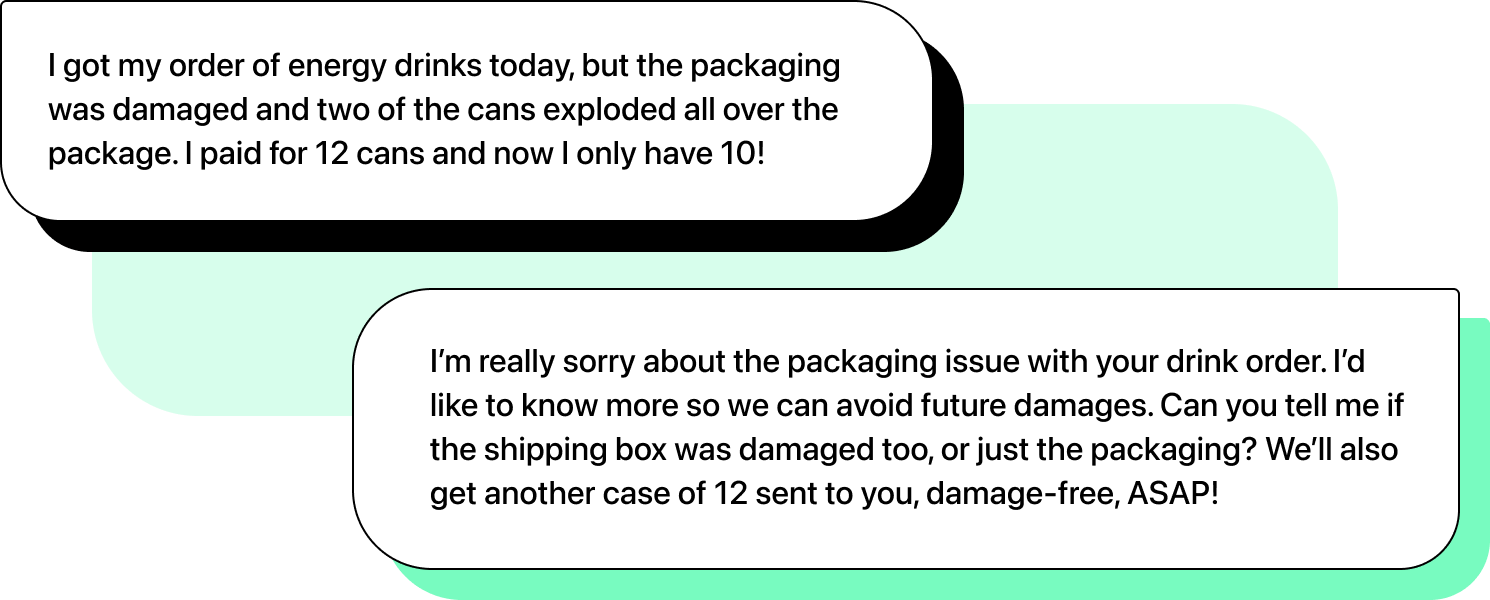
Previous support was ineffective
Customer service plays a significant role in customer satisfaction. When they need help with something relating to your product they come to you, the expert, expecting assistance. However, if they’ve had to talk to multiple agents or contact your support team for the same issue multiple times, it’s common for the next agent to feel their wrath.
As a customer service agent, you can do more in this scenario. In addition to apologizing for the inconvenience of having to ask for help multiple times, be sure to check your customer relationship management app or chat history for past chats about their concern. The last thing the customer wants to do is explain their issue again, so if you’re able to recognize and acknowledge their problem, you can demonstrate that you value their time and effort to resolve the problem.
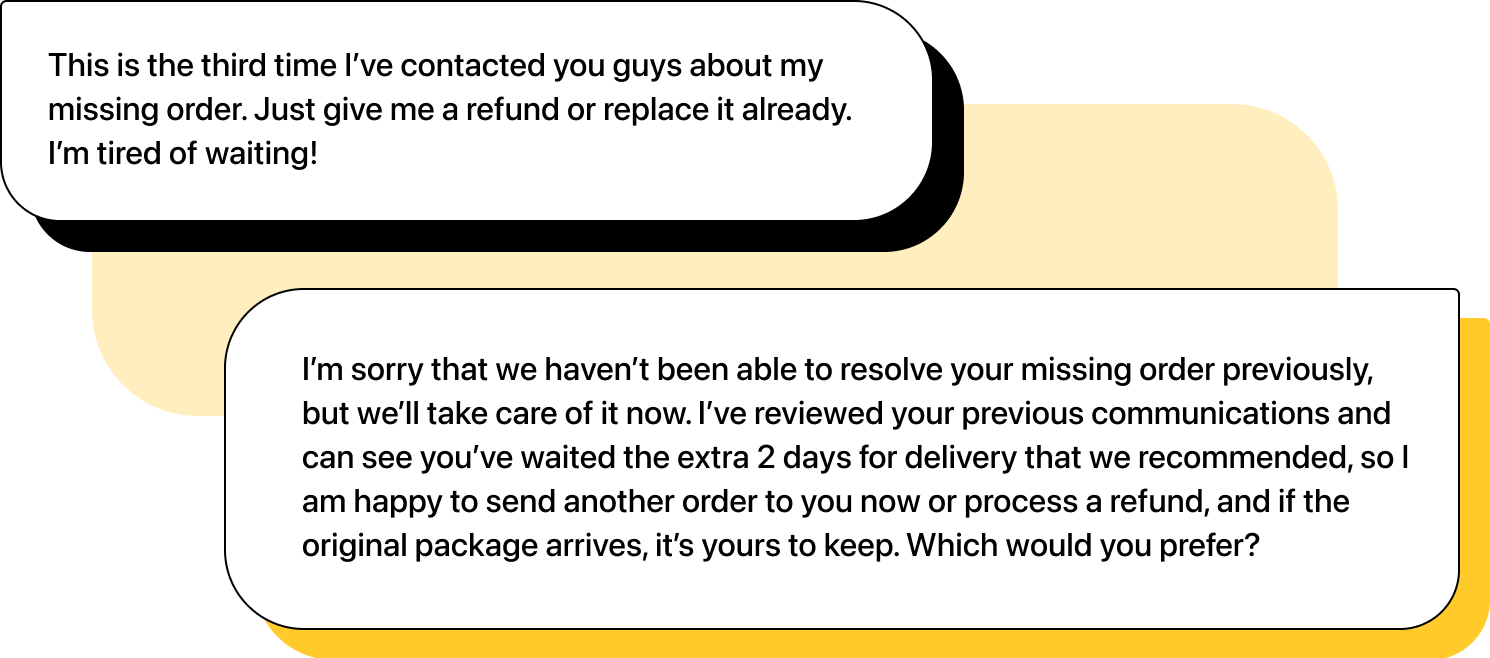
Your products aren’t in stock
Having trouble keeping your store’s catalog in stock? Selling unique or handmade products means that supply can’t always meet demand, so your products can be out of stock for extended periods of time. The same is true for limited releases like collectibles, shoes, and other pop culture items. If a customer has been waiting to get their hands on one, it’s possible that you’ll receive an angry message demanding more inventory becomes available.
The best way to address these messages is to explain why you’re having trouble keeping up items in stock. You may be experiencing higher demand than expected, your products could take a long time to make, or your supplier may only provide limited stock for exclusive items, but they might not understand that. After explaining, you should provide them with ways to stay informed about when restocks are coming, like subscribing to your SMS mailing list.
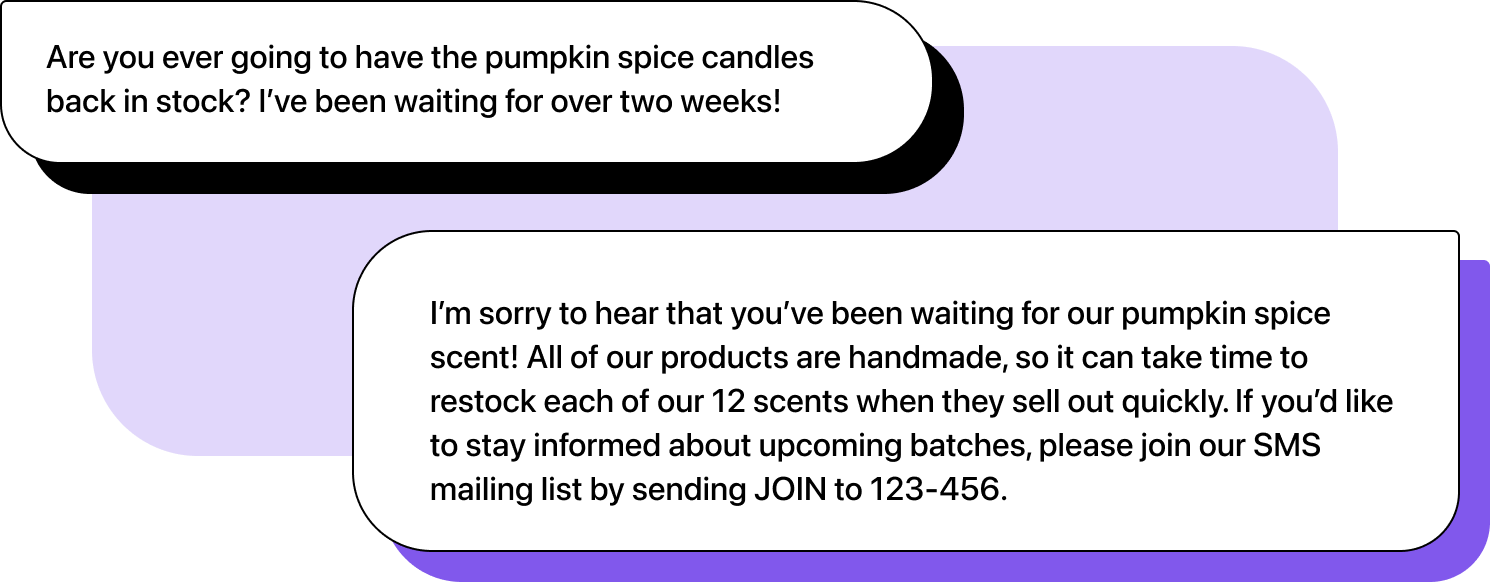
When Is It Okay to Stop Trying to Help an Upset Customer?
While you should do your best to help upset customers, there is a certain point where you should take a step back and say no.
Sometimes a customer is still angry after you have attempted to de-escalate the situation. Sometimes, they’ll become angrier. They might even shift from criticizing the company to personal insults. This level of anger is unacceptable, and you shouldn’t have to tolerate it.
Your team’s customer service policy should explain what to do in abusive customer situations. For example, you might pass the situation to your manager, end the interaction, and/or flag the customer in your service platform.
How to improve customer satisfaction and avoid angry customers
One of the best ways to manage angry customers is to avoid creating them in the first place. While there are some problems that are out of your control, like shipping problems, effective communication and customer service management can improve customer satisfaction so that they’re less likely to get angry. Here’s how.
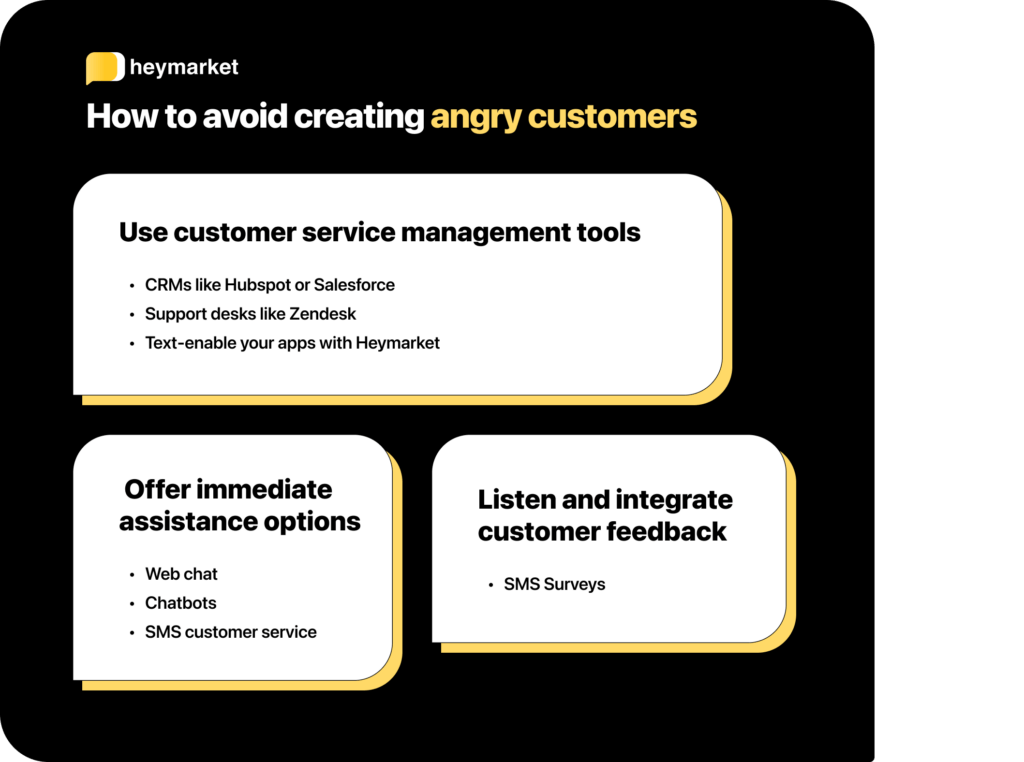
Use tools to manage customer service
Angry customers often develop as a result of poor organization or communication within your customer service team. There are a lot of working parts involved with providing effective customer service, including receiving new cases, resolving existing cases, and keeping track of past support to inform any future communication with a customer.
If your customer service team is struggling to stay on top of things because of disorganization, help desk and customer relationship management (CRM) tools can help.
CRMs hold all the critical data about your customers, including contact information, personal information, message history, and even what marketing lists they’re subscribed to. With a CRM like Hubspot or Salesforce, you can communicate more effectively with your customers and improve internal communication between your team to maintain organization.
Ticketing and help desks like Zendesk can also help you avoid angry customers by improving communication and organizing customer support cases. When you receive a new request through email, live chat, or business SMS for customer service, Zendesk creates a ticket that makes it easy to see what issues need resolving, what cases the customer has opened previously, and who is working on it. This enhanced organization improves response times and resolution times, minimizing frustration from customers looking for help.
If you use a CRM or ticketing system, you should also combine them with a business texting platform like Heymarket. With it, you can provide customer service directly from your apps and use the information stored in your CRM and help desk to inform your communication for more complete resolutions. You can also send notifications when there’s an update about a customer service ticket to keep them informed and avoid angry messages. Plus, with texting’s 98% open rate, you can be certain they’ll see your messages instead of getting buried in an email inbox.
Integrate immediate assistance options
Instant communication is an effective tool for preventing and disarming angry customers. If one of your customers experiences a problem with their order, anything else negative that happens, like waiting too long to get help, becomes a bigger deal. They may think that you don’t respect their time enough to prioritize solving their problem, which can strain relationships with valuable existing customers.
Fortunately, there are a number of different customer service chat types that you can use to improve communication and resolve problems more quickly.
Web chats are a common texting channel for providing customer assistance on your website. These two-way conversations are similar to instant messaging on social media, allowing your customer service team to instantly communicate with an angry customer so that they can resolve the situation before it becomes more negative.
Chatbots are another tool for instantly addressing customer complaints. You can program them to provide specific responses based on the messages your customer sends or the options they choose in the chatbot’s interface, answering questions quickly. Alternatively, you can use a chatbot that leverages AI models like ChatGPT to provide prompt responses based on training data you provide from real interactions.
These AI text responses provide more dynamic support than pre-configured chatbot replies but are less personal and accurate than human customer service via texting, so they’re best for addressing angry messages rather than resolving customers’ complaints. However, they can operate 24/7, allowing you to address complaints outside of business hours to prevent frustration.
Collect and implement customer feedback
If you want to improve your customer service and satisfaction, your best bet is to listen to your customers. Every interaction, including marketing communications, ordering processes, and customer support, is a learning opportunity that helps you refine your approach to meeting your customers’ needs and provide them with the level of assistance they expect.
Collecting feedback can offer you valuable insight into what’s working and what isn’t. You can leverage business SMS to collect feedback by sending SMS surveys to customers who have opted in to receive texts. You can use these texts to collect information about their experience getting assistance from your customer service team. Then, once you’ve received their feedback, you can make changes that improve customer satisfaction and avoid angry customers in the future.
How Would You Handle an Angry Customer?
Learning how to deal with angry customers is hard, but not impossible. Ultimately, these tips boil down to three: understand customers’ frustration, show them that you’re there to help, and take care of yourself in the process.
Your business should also have its own special tactics for dealing with angry customers. For example, you might try customer appeasement by offering a gift card to extremely upset customers, giving a free month of a subscription, or providing an upgraded service.
While there’s no formula for dealing with angry customers, these tactics can help you find what methods work for you to tackle these situations as best you can.







